
My auntie took Stuart and me to the newly renovated Kelvingrove Art Gallery and Museum and I made a couple drawings based on some of the pictures. I love the face on this kid, from a series of photos taken by Joseph McKenzie of kids in Glasgow's Gorbals. But darn, he was hard to draw! He kept looking like an old man, which is part of his charm, really, but he shouldn't actually look like an old man. I finally ended up thinking, what would Gary do, and drew him that way, which seemed to work the best.
This one isn't spot on either, but I loved the gormless expression and composition of this painting by painter and optical repairman John Quinton Pringle, one of the Glasgow Boys. The gallery was displaying a large collection of work by the Glasgow Boys, which will be on exhibition at the Royal Academy next year (when you'll have to pay a whopping fee to get in. See 'em for free in Glasgow!). 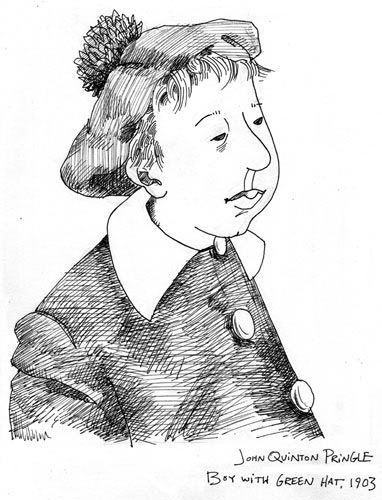

Here's an eyeglasses sign, painted, I think by Pringle again. Sort of spooky looking and very cool.
The museum's laid out as sort of cross between London's Natural History Museum, the V&A and the Horniman, but with entirely different stuff, lots of amazing Scottish paintings. Here's Sir Roger the Elephant, who was so big he couldn't be removed when they were doing renovations, so they just boxed him up on the spot.
Some lovely icky bugs:
Here's the spire of Glasgow University, where my dad studied: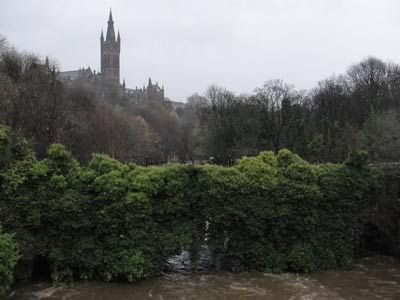
Another place we visited was the Scotland Street School, designed entirely by one of Scotland's best-loved architects, Charles Rennie Mackintosh. (You can see a drawing of it here on the wall of its local subway stop, Shields Road. We had fun riding the Glasgow subway, which originally worked by having its trains clamp onto a moving circular cable, thus its nickname the Clockwork Orange. (Here's my auntie and Stuart stopped at Ibrox station, which is next to the big Rangers football club where my cousin once took my sister to a match. She came back knowing all these songs that made my aunt and uncle blush.) 




They even had a class full of school children in Victorian outfits being taught by a cranky old teacher, who apparently is the only teacher in Scotland who will threaten to cane them, even if he can't legally carry out his threat. One of the hallway invigilators said the kids really love this.
Viewing: Blog Posts Tagged with: scotland, Most Recent at Top [Help]
Results 76 - 89 of 89
Blog: Sarah McIntyre (Login to Add to MyJacketFlap)
JacketFlap tags: holiday, glasgow, scotland, Add a tag
Blog: Biblio File (Login to Add to MyJacketFlap)
JacketFlap tags: Adult, Scotland, Muriel Spark, Fiction, Add a tag
The Prime of Miss Jean Brodie Muriel Spark
Miss Jean Brodie is a teacher at an Edinburgh day school in the 1930s and is best explained on page 62: There were legions of her kind during the nineteen-thirties, women from the age of thirty and upward, who crowded their war-bereaved spinsterhood with voyages of discovery into new ideas and energetic practices in art of social welfare, education or religion. The progressive spinsters of Edinburgh did not teach in schools, especially in schools of traditional character like Marcia Blaine's School for Girls. It was in this that Miss Brodie was, as the rest of the staff spinsterhood put it, a trifle out of place... it goes on in for another three pages...
Miss Brodie is a woman in her prime, full of new and unconventional ideas, hemmed in by the conventional and conservative school. She admires Mussolini. She takes a lover. She has great passion for the arts. She is forever under suspicion from the headmistress who constantly looks for things to use against her. She takes five girls under her wing and they form the Brodie set, girls that she holds close all through their years at the school and that she attempts to mold in her own image. One of them will betray her.
What we get is a darkly (and subtly) funny character study of a woman who is convinced that she is in the prime of her life and invincible. The narration jumps all over the place in terms of time, but never in a confusing way. We know what the girls will do in bits and spurts and find out slowly how they get there. Spark reveals one piece of the mystery of the betrayal and one piece of each character as a whole, slowly building complete characters and plot into completion. Along the way, she explores loyalty and manipulation.
I initially wanted to read this because Jenny Davidson mentions it in the back matter of The Explosionist (are we getting a sequel to that any time soon?!), and then it appeared on the list of 1001 Novels to Read before you Die and the Guardian's list of 1000 Novels to Read Before You Die.
It's a wonderful story with hidden depth. I've been puzzling over it and thinking over it for quite some time before I was able to write this review. It seems rather basic (although the unlinear narration was a novelty at the time of publication) but the depth of the character study, and not just for Miss Brodie, but for many of the girls in her set, comes out upon further reflection.
Book Provided by... my local library
Links to Amazon are an affiliate link. You can help support Biblio File by purchasing any item (not just the one linked to!) through these links. Read my full disclosure statement.
Blog: Sarah McIntyre (Login to Add to MyJacketFlap)
JacketFlap tags: holiday, scotland, Add a tag
Planning a November visit to Scotland is dodgy at the best of times, but wouldn't you know it, we managed to hit it during one of the wettest weekends in recorded history. Here's Suzie the border terrier, sneezing on the swollen riverbank of the Bladnoch.
Before Angus met us in Dumfries to take us out to his farm, we had a little look at what the River Nith was getting up to. Scottish words such as dreich and drookit spring to mind.
Stuart and I were well impressed by Dumfries' selection of sandbags. 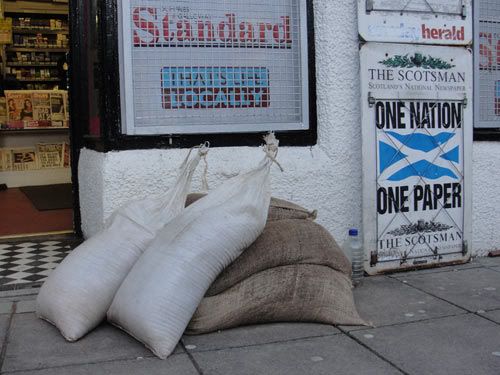

This pub's appropriately named 'The World's End'.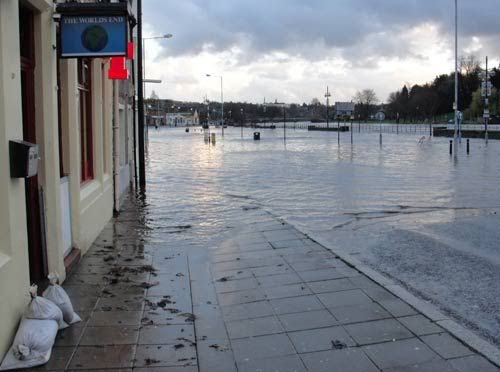
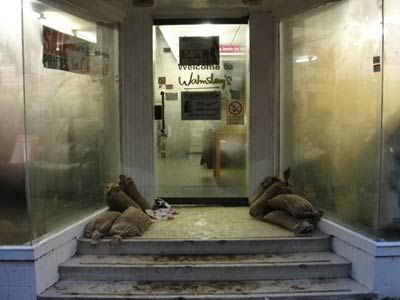
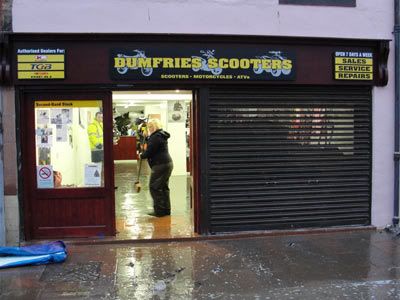
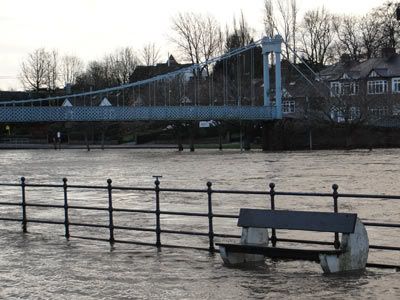
Moving on, here's a bleak looking view of the Isle of Whithorn. We mostly stayed in the pub.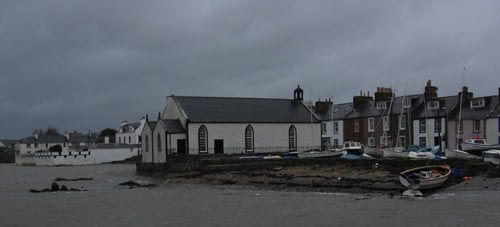
Here's the place in Wigtown where some Covenanters were tied to a stake and left to a watery death.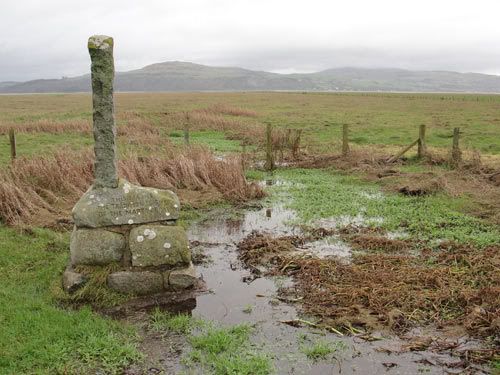
More wetness along the riverbank.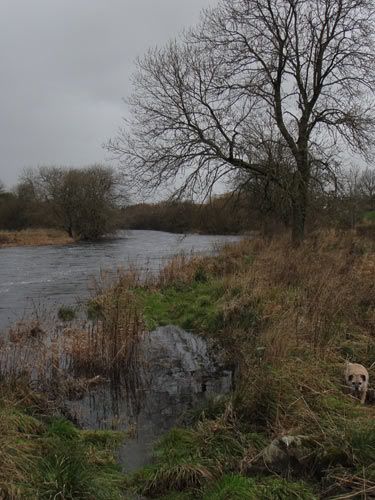
Actually, we had a very good trip, despite all this. But it was great being able to cuddle up by the fire with some warm animals in the evenings (Suzie and Sweep). ...More on Scotland later, when we dry off a bit.

Blog: the thinkings of a lili (Login to Add to MyJacketFlap)
JacketFlap tags: family, me, scotland, Add a tag
So I did three wonderful events at the Edinburgh Book Festival back in August, and then the awesome folks at the Scottish Book Trust took me out into the country for a day to meet some young Scottish folk.
One of the towns we visited was Brechin, about 2 hours north of Edinburgh. Now Brechin is an interesting town (populatioon about 7000) for the following reasons:
1. It has a very nice 13th Century cathedral, with a round tower dating from about 1000AD.
2. Robert Watson-Watt, an important pioneer in the early development of radar was born there.
3. As was my great-great-grandfather, William Ross.
William was the illegitimate son of a woman called Jessie Mitchell. He emigrated to Australia as a young man, but his own son moved back to England, before HIS son (my grandfather) moved back to Australia. I had some time to go to the cathedral, and I found this in the churchyard: It was also really awesome meeting some real live Scottish students, in their second ever week of high school. Here I am with a few of them:
It was also really awesome meeting some real live Scottish students, in their second ever week of high school. Here I am with a few of them:
Thanks, Edinburgh Book Festival and Scottish Book Trust for showing me such a great time!
Blog: The Winged Elephant (Login to Add to MyJacketFlap)
JacketFlap tags: scotland, rosemary goring, scotland: the autobiography, robert burns, Add a tag
 Early birthday greetings go out to the great Scottish poet Robert Burns, who turns 250 on Sunday, January 25. In Rosemary Goring's recent account of Scottish history, Scotland: The Autobiography, she includes both the famous review by Henri Mackenzie of Burns's first collection of poems in 1786, and Sir Walter Scott's account of his meeting with Burns in 1787.
Early birthday greetings go out to the great Scottish poet Robert Burns, who turns 250 on Sunday, January 25. In Rosemary Goring's recent account of Scottish history, Scotland: The Autobiography, she includes both the famous review by Henri Mackenzie of Burns's first collection of poems in 1786, and Sir Walter Scott's account of his meeting with Burns in 1787.
Blog: OUPblog (Login to Add to MyJacketFlap)
JacketFlap tags: History, Poetry, Literature, UK, A-Featured, World History, VSI, scotland, very short introduction, homecoming, rab houston, robert burns, Add a tag
2009 sees the 250th anniversary of the birth of Scotland’s most famous poet, Robert Burns. In the post below Professor Rab Houston of St. Andrew’s University looks at the history behind the tradition of Burns Suppers, and dispels some myths about their origin.
Rab Houston is the author of Scotland: A Very Short Introduction, and has previously written for OUPblog here and here.
Even before his death, poet Robert Burns’ cottage at Alloway, Ayrshire, had been sold to the incorporation, or guild, of shoemakers of Ayr, one of whose members turned it into an alehouse. It was here, on 29 January 1801 (they got his birthday wrong) that soldiers of the Argyll Fencibles (militia) met to hear their band play – and to use the services of his cottage in its new role.
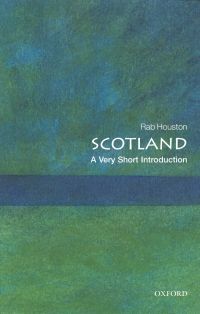 The first recorded Burns Supper took place at Alloway in the same year, but on the anniversary of his death (21st July). It involved a speech and multiple toasts; to eat there was haggis (which was addressed) and, a mercifully lost tradition, sheep’s head; given the social status of those present, refreshment was probably wine and ale rather than whisky. Present were nine friends and patrons of Burns. Among them was a lady, though thereafter the Suppers were mostly (sometimes militantly) all-male affairs until far into the twentieth century: a curious slant on Burns’ own life as well as on the first dinner. The ‘toast to the lasses’ was traditionally thanks for the cooking and an appreciation of the women in Burns’ life, only later degenerating into a sexist (often misogynistic) rant.
The first recorded Burns Supper took place at Alloway in the same year, but on the anniversary of his death (21st July). It involved a speech and multiple toasts; to eat there was haggis (which was addressed) and, a mercifully lost tradition, sheep’s head; given the social status of those present, refreshment was probably wine and ale rather than whisky. Present were nine friends and patrons of Burns. Among them was a lady, though thereafter the Suppers were mostly (sometimes militantly) all-male affairs until far into the twentieth century: a curious slant on Burns’ own life as well as on the first dinner. The ‘toast to the lasses’ was traditionally thanks for the cooking and an appreciation of the women in Burns’ life, only later degenerating into a sexist (often misogynistic) rant.
Celebrations were held twice yearly until 1809 when participants settled on January (25th), because this fell in a slack period of the agricultural year. Commercialisation of his birthplace did little to honour the memory of his life and work, and in 1822 the poet John Keats complained bitterly of how both the ambience and the landlord of the Alloway inn degraded Burns’ greatness.
Any group of individuals can hold a Burns Supper. These blend sociability and conversation, keynotes of the Scottish Enlightenment, with more universal practices such as commensality and drinking. Sociability could be more consistently promoted by associations. Set up in the early 1800s, Paisley (which has the earliest extant minute book starting in 1805) and Greenock vie for the title of first Burns Club, but after 1810 these associations proliferated. Popularised in the press, Burns Suppers and Burns Clubs were widespread by 1830 not only in his native Ayrshire, but also throughout Scotland. The great Ayr Festival of 1844 enhanced international awareness of the celebration, and the creation of the Burns Federation in 1885 brought together hundreds of Clubs worldwide. There are as many as 400 affiliated clubs nowadays. The first all-female club was founded at Shotts in Lanarkshire in 1920, and the Federation, now based in Kilmarnock, had to wait until 1970 for its first woman president.
Burns died at a time of profound economic, social and political change when writers perceived that Scottish identity was being lost. Romantic and anti-modernist, they found in him a symbol of an allegedly uncorrupted Scotland. Burns became a uniquely elastic symbol over time and space, as valuable to those who did not know his language (English or Scots) as to those who did; to laissez-faire liberals (nineteenth century) as to radicals and socialists (twentieth century); to the urban middle classes as to the rural working people from which Burns and his inspiration came; to Japanese as to those of Anglo-Saxon stock; to temperance campaigners as to generous imbibers; to nationalists as to unionists. The cult surrounding him has been reshaped many times in the two centuries since his death. Identities have moulded representations of Burns as much as Burns has formed identities, but Burns has proved a uniquely enduring and accessible icon. Celebrating the centenary of his birth in 1859, the Boston, Mass. Burns Club, founded in 1850, affirmed that there had ‘never been any national, sectional, or other bar to membership’, other than a love of liberty and republicanism.
Representations of Burns mix the particular and the historically accurate with the general and the fabricated. So too with the Suppers that commemorate him. They have been appropriated to express bourgeois male solidarity and commercial needs as much as universality, though it is possible that the enduring popularity of these gatherings lies in their safely apolitical nature.
It is curious that an invented and reinvented tradition bearing Burns’ name should have become a powerful symbol of Scots at home and, even more, abroad, when another active contribution of his has been so little developed. This was his confident and skilful use of Scots. Burns was celebrated in the nineteenth century for preserving a dying language, and the use of Scots is integral with the Suppers. Yet it is another surrendered or suppressed tongue, Gaelic, which has been resuscitated in the guise of an independent ‘national’ language in modern Scotland. This is despite never having been spoken by all Scots, even in the middle ages, and being now spoken by just 1% of Scotland’s population, most of whom live in greater Glasgow.
Blog: OUPblog (Login to Add to MyJacketFlap)
JacketFlap tags: kilts, A-Featured, World History, VSI, scotland, very short Introductions, rab houston, History, UK, Add a tag
Rab Houston is Professor of Modern History at the University of St Andrews, and the author of Scotland: A Very Short Introduction. In the piece below he questions whether kilts are as integral to Scottish identity as some people think.
His previous OUPblog post can be found here, and remember to check back next week when Rab will be writing about Burns Suppers.
Some wag once wrote that kilts outside the Highlands were merely fancy dress. Fortunately that is no longer the case. Seeing the kilt worn with a new confidence is an inspiring sign of how far modern Scotland has come from the tartan tokenism of the 1970s.
 Yet it is worth remembering that the kilt was a skirt invented by an Englishman in the 1720s. Highlanders traditionally wore bolts of cloth called ‘plaids’ that could fall off the hips or be gathered like trousers. Lowland men wore trousers. Tartan too comes not from some authentic ancient pool of Scots historic culture, but gained its importance during the eighteenth century as a national symbol of what Scotland could contribute in men and materials to British imperialism. Highland identity became firmly associated with Scottish identity in the nineteenth century, encapsulated in the romantic image of the Scot-as-Highlander that was popularised by Queen Victoria.
Yet it is worth remembering that the kilt was a skirt invented by an Englishman in the 1720s. Highlanders traditionally wore bolts of cloth called ‘plaids’ that could fall off the hips or be gathered like trousers. Lowland men wore trousers. Tartan too comes not from some authentic ancient pool of Scots historic culture, but gained its importance during the eighteenth century as a national symbol of what Scotland could contribute in men and materials to British imperialism. Highland identity became firmly associated with Scottish identity in the nineteenth century, encapsulated in the romantic image of the Scot-as-Highlander that was popularised by Queen Victoria.
Scots have appropriated another ambiguous way of showing they are not English. It is surely right that the ancient Gaelic language should experience new life and be granted equal respect, for it may for a time have been Scotland’s majority tongue. However, it was never the only one. Even in the Dark Ages there was extensive English- and Scots-speaking in the south-east and Norse dialects too thrived across much of the north-west. What is truly distinctive about Scotland’s linguistic past is not Gaelic, but the remarkable diversity of tongues in so small a country.
The lobby for Gaelic shows that we appreciate diversity now more than ever and it has helped us to focus on what it means to be Scottish. Indeed there is much that is more substantial and more completely distinctive to Scottish identity than these symbols. Scots are proud to be different without always appreciating just how distinct Scotland past and present really is from the rest of Britain. What makes us Scottish is above all a sense of history that goes much deeper than the tokens of dress or even a discrete language that arguably allows us to speak more eloquently about being different.
What do we know of that history? Like others in the Anglo-Saxon world, we understandably seek identity, empathy, and meaning for our private present by researching family or local history and we want to know about wars and history’s celebrities. After all, history is experienced by individuals and to be alive is to be touched by the past.
But our social and political present is also formed by powerful forces that constitute our public past. There was a separate national church, both Catholic in the Middle Ages and Protestant from the Reformation, the latter in turn a set of religious changes far more radical than occurred in England. Add to this a distinctive legal code, rigorously grounded on principle yet at the same time flexible and potentially humane. Scots law drew on indigenous influences, but it came mostly from the Continent rather than England, as did the most important artistic, architectural and musical styles exemplified in Scotland. In turn, Scots could be found all over north-west Europe and later around the globe. Among the ideas, techniques and technologies they took with them there was an ethos of educational opportunity, fostering a belief in common humanity that flourished during the Enlightenment and after.
Top this off with a very different experience of government. From the Middle Ages ideas of political freedom and individual liberty created an egalitarian ethos that has never faded. An important reason Scottish devolution has worked so well is not just because it had its own parliament until 1707. Historic Scotland was a highly de-centralised state and there was an effective civil society: forms of association below and outside the apparatus of the state, such as churches, communities, and families, mediating between public institutions and private lives, which now so concern the modern West. Scots felt that central authority could and should intervene for benign ends, but that most power should be diffused. This internal devolution was essential because of the remarkable local and regional diversity of the country, creating a rich mixture of cultures that allowed people to forge multiple identities within Scotland.
All of these marked Scotland out from England and the legacy of this distinctive past touches us still in ways we only dimly appreciate. More tangibly, it means that Scots are no less Scottish if they do not wear kilts and they do not speak Gaelic. We should wear kilts and speak Gaelic with pride if we want to, but we do not need them nearly as much as an appreciation of the historic forces that have given us our unique identity.
Blog: OUPblog (Login to Add to MyJacketFlap)
JacketFlap tags: History, UK, Politics, A-Featured, united kingdom, World History, VSI, scotland, devolution, scottish parliament, Add a tag
Professor Rab Houston is the author of Scotland: A Very Short Introduction, which publishes in the UK today. He is Professor of Modern History at St Andrews University, and his previous books include Autism in History: The Case of Hugh Blair of Borgue and Literacy in Early Modern Europe: Culture and Education 1500-1800. In the piece below, Rab looks at why Scottish devolution has worked.
A common but erroneous line in the English press is that Scottish devolution only works because London bankrolls it. The truth is that Scotland’s historic experience of diffused power and local administration has facilitated the functioning of modern devolved government.
Scotland and England have been in Union for three centuries. Joined less at the hip than by a fingertip, they have managed (with Wales and Northern Ireland) successfully to promote a British project in spite of a centuries-old legacy of distrust, double-dealing, broken promises, and betrayal. Since 1999 Scotland has readjusted in part to what it was before 1707: a completely independent state with distinctive experience of government, religion, law, education, social relationships, population mobility, and culture. The success of devolution comes not only in the restoration of a measure of independence, but also arises from the way Scotland was governed both before and after Union.
 For the last millennium the genius of Scotland’s political development has been simple. It lay not in developing coercive state power, but in accommodating plural forms within a structure of government where the touch of the centre was usually light. Scotland was for centuries socially hierarchic and politically oligarchic, but it was also governmentally ‘heterarchic’, organizing itself into a functioning whole without recourse to the compulsive mechanisms that its English neighbour took for granted. There was an element of centralized political power focused on the authority of kingship, but the essence of Scotland’s historic government lay in devolving, directing and co-ordinating rather than controlling. Scottish kings secured a measure of harmony through a process of ethnic accommodation – admittedly not always easily realised - underpinned by core values. Loyalty to the monarchy and shared Christianity were the most important and enduring symbols of unity, with a later admixture of Britishness forging a distinctively Scottish ‘unionist nationalism’. The reservoir of symbols has changed over the centuries, but the sense of identity rooted in history has not.
For the last millennium the genius of Scotland’s political development has been simple. It lay not in developing coercive state power, but in accommodating plural forms within a structure of government where the touch of the centre was usually light. Scotland was for centuries socially hierarchic and politically oligarchic, but it was also governmentally ‘heterarchic’, organizing itself into a functioning whole without recourse to the compulsive mechanisms that its English neighbour took for granted. There was an element of centralized political power focused on the authority of kingship, but the essence of Scotland’s historic government lay in devolving, directing and co-ordinating rather than controlling. Scottish kings secured a measure of harmony through a process of ethnic accommodation – admittedly not always easily realised - underpinned by core values. Loyalty to the monarchy and shared Christianity were the most important and enduring symbols of unity, with a later admixture of Britishness forging a distinctively Scottish ‘unionist nationalism’. The reservoir of symbols has changed over the centuries, but the sense of identity rooted in history has not.
Scotland contained within its small compass many productive tension between different regions and cultures, of which the Highland-Lowland divide is only the most obvious. Since the time of Cinaed mac Alpín in the ninth century the success of kings in Scotland lay in accommodating diversity of race, ethnicity, language, lifestyle and social organization. From the fourteenth century Stewart monarchs tried by education policies and other means to reconcile and assimilate the ‘wyld wikked hielandmen’ with Lowlanders, but they were always aware that part of their kingdom’s heritage lay with a distinctive Highland culture. During the eighteenth century another bridge was built as tartan became a symbol of what Scotland could contribute in men and materials to British imperialism. Highland identity became firmly associated with Scottish identity in the nineteenth century, encapsulated in the romantic image of the Scot-as-Highlander that was popularised by Queen Victoria.
The tensions were creative because rulers reached important accommodations with local and regional diversity, enshrined in substantial degrees of local government autonomy. The enduring power of the nobility is one example, but Scotland’s largely self-governing towns also exemplify the strength of devolved authority. Burghs were financially flexible, empowered to respond to changing needs by legislation enabling them to charge additional levies on, for example, the sale of beer. Acts hypothecated the taxation to specified ends: Greenock built its new harbour in the mid-18th century using beer money and Edinburgh, among other things, to build churches and to fund its University’s chair of law. Many towns too had corporate endowments and incomes, known as the ‘Common Good’, which they were legally obliged to use on collective necessities. Sometimes that just meant corporate junketing, but it also delivered a social dividend in the promotion of a wide spectrum of both private activities and public interests ranging from clubs and welfare projects to civic histories and buildings. The importance of family, community, and locality that this focus implied is preserved in gravestone inscriptions from across 18th- and 19th-century Scotland.
The essentially local core of political and social life is also clear in British lawmaking on Scotland. In the half century before it was subsumed in 1707, the Scottish Parliament produced two-thirds of all legislation in Britain, but three-quarters of the acts were ‘private’, affecting particular towns or districts. After 1707 Scotland’s representatives used their time on the same local issues and kept distinctively Scottish law and religion out of the British parliament. Only in the field of economic policy did post-1707 politicians continue legislative attempts to foster national growth: for example, protection and bounties for the linen industry from the 1740s.
Being local did not necessarily mean acting parochially. Sometimes regulation was not just acceptable, but necessary and Scots were more comfortable accepting interventionist social policies than were the laissez faire English. An important example was the regulation of rents that began with the Glasgow rent strikes of 1915 and ended with massive government investment in housing in the era of the Welfare State. Yet Scots were also prepared to resist the power-seeking impulses of the centre and to promote a strong ‘civil society’ or ‘voluntary sector’ of collective action in bodies as diverse as trades unions, churches, social or sporting clubs, and neighbourhoods. These associations were autonomous, overlapping and sometimes competing, but they relied for their strength on a shared acknowledgement of the legitimate claims of all members of society, individuals and groups alike, in an interconnected whole.
It is the appreciation of diversity and the strength of internal political devolution that explains the many good things about modern Scotland. As much as the fact that Scotland was once independent, the way it was governed in the past and the means its people used to create multiple lines of authority accounts for the success of modern devolution.
Blog: The Winged Elephant (Login to Add to MyJacketFlap)
JacketFlap tags: scotland, rosemary goring, scotland: the autobiography, Add a tag
 In a wide-ranging survey of recent books on Scotland in The New York Review of Books, Andrew O'Hagan notes that "Rosemary Goring's Scotland: An Autobiography is a spirited collection of witnessing from all periods of Scotland. The choices she makes are quite exquisite and collectively the book fulfills the very needful function of telling the Scottish story itself . . There are two hundred witnessings and it is hard to imagine many countries near Scotland's size being able to provide such a gigantic vision of human progress, ingress, regress, and finesse."
In a wide-ranging survey of recent books on Scotland in The New York Review of Books, Andrew O'Hagan notes that "Rosemary Goring's Scotland: An Autobiography is a spirited collection of witnessing from all periods of Scotland. The choices she makes are quite exquisite and collectively the book fulfills the very needful function of telling the Scottish story itself . . There are two hundred witnessings and it is hard to imagine many countries near Scotland's size being able to provide such a gigantic vision of human progress, ingress, regress, and finesse."
Blog: laurasalas (Login to Add to MyJacketFlap)
JacketFlap tags: scotland, Add a tag
OK, this is not writing-related. But many of you have asked to see Scotland pictures, and I'm happy to share! First, we flew to Amsterdam (8-1/2 hour flight) and had a layover of about 7 hours, so we were able to go into the city for the morning, which was great. The captions for the first 10 pix are so are below each image, but then it changes to above. Sorry for the confusion!
OK, the captions now change to ABOVE the images. Sorry. I'm just getting this feature figured out!
Back on the mainland, we drove to Fort William for some canyoning. This is where you climb, slide, and jump down waterfalls. Here's Randy getting pushed by the guide on a sliding section. This was fun but rocky! I ended up with huge bruises on my hip, knee, elbow, and palm. |
 |
Here's someone in our group on the medium jump. The big jump we did later was about a 30-foot jump, depending on the water level that day. It was amazing! The compression of your wetsuit around your chest when you jump from that height, and then the shock of the icy water after a few seconds in air--a complete rush. |
 |
Here I am at the top of a small jump. The slippery rocks we had to scramble on were much more challenging and scary to me (with my bad knee) than the sliding or jumping. Canyoning was incredible. Probably my favorite single activity of the whole vacation. |
 |
Battered and exhausted, we headed to our B&B in Fort William. This was the beautiful view from our window. It looked like we could stretch out a hand and grab those clouds on the mountain. |
 |
And that was Monday, a week after we flew in. So that concludes Week 1 of our trip! I'll share pix from the second week tomorrow.
P.S. I was working on this post on Sunday, Mother's Day, early in the morning while mysterious preparations were going on upstairs. What a fantastic surprise it was to find that Randy had tracked down a recipe and prepared Sticky Toffee Pudding for me (not a quick and easy recipe) and had ordered me a GPS unit while we were still in Scotland, so that it would arrive in time for Mother's Day. Lovely! Add a Comment
Blog: laurasalas (Login to Add to MyJacketFlap)
JacketFlap tags: school visits, scotland, Add a tag
We're home!
I'll be posting about our trip in general, but today I'm actually going to jump in with a writer-related post.
Our last night in Scotland, we went to a Matchbox Twenty concert in Glasgow (opening act Headway). Here's a cut of 3 a.m. someone posted on YouTube, if you're interested.
The concert was great! We had hoped to see one of the Scottish bands we like while we were over there, but they were all touring out of the country. So we saw an American band instead. But after two weeks of hearing American rock and pop bands every time we went into a pub, restaurant, or taxi, it didn't seem that odd at all.
Anyway, the funniest part of the concert was that the organ broke early on. After a couple of minutes of the crew messing with stuff not being able to fix it, frontman Rob Thomas 
improvised a song with the rest of the band jamming along. "I'm just sitting here in Glasgow...with technical difficulties..." Then he said, "You know, when you're talking about this concert later to friends...let's just not mention this part, ok?" He took a situation where the crowd could've gotten impatient and frustrated and turned it into a problem we shared, just one of life's curve balls. And he made it funny and exasperating and had everyone rooting for them.
So what does this have to do with life as a children's writer? I thought this was a good lesson for writers doing school visits. One of my big fears is technical difficulties. In fact, on my two-day visit recently, the remote for the PowerPoint didn't work. I like planning everything out, but as our presentations get more and more high tech, we're of course more dependent on the technology. But here are the school visit tips I took away from a technology-challenged concert that still managed to be hugely successful.
When your equipment fails:
laugh about it
make the kids complicit somehow (This'll be our secret, right? Don't tell the third graders or they'll stage a riot in the halls!)
ask the kids for help ("Anybody happen to have an overhead projector on them?")
mention the school name a lot--remind the kids that you're here, in person, in their own school, and that's a cool thing whether the document camera screws up or not
remember that the kids are there to see you, and while they might not be as big of fans of you as they are of Miley Cyrus, they still want you to succeed. They want to be entertained--and that can happen whether your equipment breaks or not
improvise. Have a backup of some kind. Does holding up pictures work as well as your PowerPoint? No. But joke about it and do the best you can. If someone was trying to fix the problem for me, I would meanwhile perhaps make up a bad poem on the spot about never trusting technology. Maybe I'd ask the kids to help me write the poem. If the technology is a lost cause, move on to Plan B. Don't waste 20 minutes of a 45-minute presentation trying to fix something.
laught about it. I know, that's a repeat, but it's important. If you're totally stressed out about it, the kids will pick that up and think your presentation is a failure. Instead, you want the buzz to be like the Matchbox Twenty buzz, where fans online were talking about the technical difficulties but were amazed and entertained by how well you handled it.
Anybody have any tragic/funny school visit technology stories to share?
Blog: laurasalas (Login to Add to MyJacketFlap)
JacketFlap tags: scotland, Add a tag
I'm saying hi from Scotland's Secret Bunker today--it's an underground bunker that for decades was disguised as a farmhouse. It was first a place for Scotland to monitor by sonar possible incoming nuclear missiles. Then it became a bunker for high-placed officials in case of nuclear war. But it was all secret and supposedly even the surrounding farmers didn't know what it was. It was opened to the public in the 90s and is off the beaten track south of Dundee. And they have free internet. Cool!
OK, I'm off to explore the bunker some more. I'm thinking this would be a really neat setting for a mystery/thriller. Maybe someone could get accidentally locked in.
Blog: laurasalas (Login to Add to MyJacketFlap)
JacketFlap tags: scotland, Add a tag
Hi everybody! I'm blogging from the Posh Nosh cafe in Tobermory on the Isle of Mull. It's a wet, rainy day, but we've mostly been in the car (driving on terribly narrow one-lane roads!), so I'm not too drenched. We're staying at Glengorm Castle and having a wonderful time. We'll head back to the mainland in a couple of days.
I'm not doing any real writing, but I'm filling my head (and notebook) with details about Scotland for future use.
I hope you're all having an absolutely terrific last half of April!
Blog: Garden Painter Art (Login to Add to MyJacketFlap)
JacketFlap tags: collage, eBay, mixed media, Garden Painter Art, Kimberly Wlassak, Etsy, vintage photos, running around, Add a tag
Good Afternoon Bloggers:
I've been busy this morning listing a bunch of my original ACEOs on eBay. I haven't listed there in a very long time, but I thought I would give it another whirl. Listing helps to get me in the mood to create some new pieces!! Here's what I have listed on eBay.
********************************************
I have a little running around to do today. I'll swing by my mom's place to organize her meds for the week, then I'm off to the grocery and then to my dear friend's house to see her new Golden Retriever pup. Tomorrow....The Beach!!! So, I've just stopped by my blog briefly today to say hi and keep in touch.
Until Friday:
Kim
Garden Painter Art



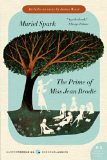



































and may I recommend the movie! It's very well done. :)
I'm glad to hear it! Also, Dame Maggie Smith! Who doesn't love her? I must add it to my Netflix queue.
EXPLOSIONIST sequel is INVISIBLE THINGS, I am just finalizing copy-edited manuscript and it will be out in fall 2010 - glad you liked the Spark novel!
Huzzah! I can't wait for it! Thanks for letting us now, and thanks for planting the name of this in my brain, so that it caught my eye on other lists!